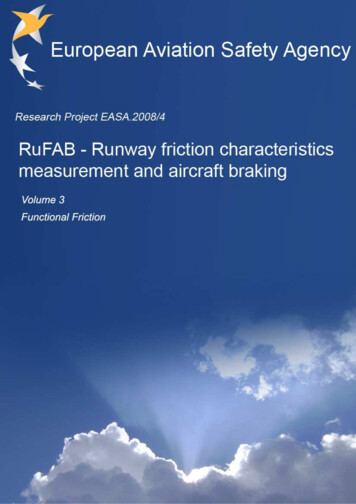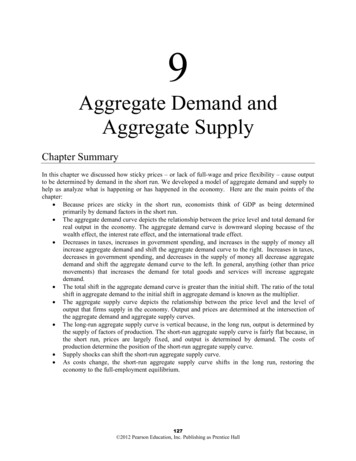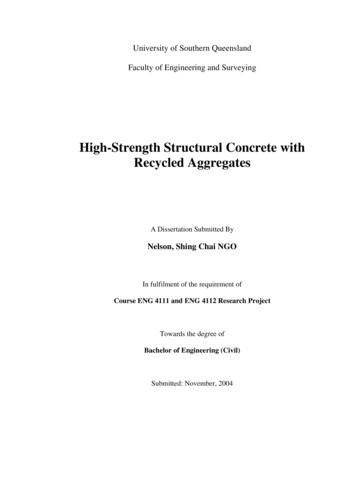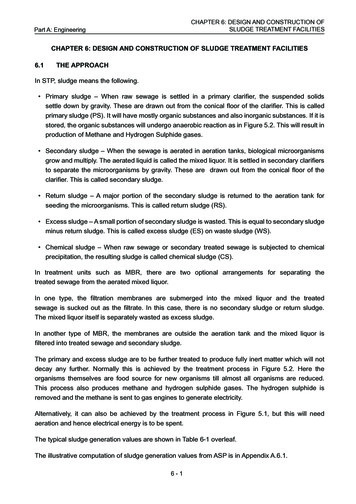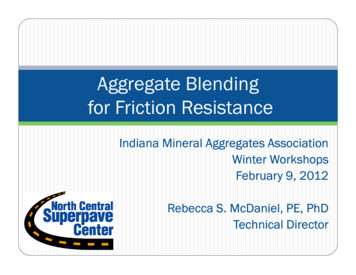
Transcription
Aggregate Blendingfor Friction ResistanceIndiana Mineral Aggregates AssociationWinter WorkshopsFebruary 9, 2012Rebecca S. McDaniel, PE, PhDTechnical Director
FrictionFriction-Related Projects at NCSCIdentification of Laboratory Technique toOptimize Superpave HMA Surface FrictionCharacteristics (completed)Evaluation of Recycled Asphalt Pavementfor Surface Mixtures (draft final report in review)Maximizing the Use of Local Materials inHMA Surfaces (draft final report submitted)
Goals for Required Lab MethodTest friction and textureAccelerate polishingTest asphalt mixtures, not aggregates onlyIdeal to be able to test in lab and fieldLed to identification of Dynamic FrictionTester and Circular Track MeterNeeded a polisher to matchIdea from NCAT, refined by NCSC
BackgroundPavement friction is function of microtextureand macrotexture.Microtexture – provided by aggregate surfaceMacrotexture – determined by overall properties ofthe pavement surface (NMAS and gradation ofaggregates, binder content, etc.)Friction at the tire-pavement interface iscaused by:Adhesion – between tire and surface (microtexture)Hysteresis - deformation of tire around surfaceirregularities (macrotexture)
Designing for Pavement FrictionMost states specify allowable surface aggregates bytype based on historical usage and aggregate tests.Useful, but do not consider macrotexture.Need mixture test and specifications.Widely available aggregates are carbonates.Tend to polishPolish resistant aggregates are not readily availableand must be hauled in -- .Coarser mix texture may reduce the need for highmicrotexture aggregates.
Dynamic Friction Tester (DFT)(a)DFT – dynamic friction at 20 km/h (DF20)
Circular Track Meter (CTM)(b)CTM – Mean Profile Depth, mm
International Friction Index 40F 60 0.081 0.732DF20e SpIFI (F60, Sp)S p 14.2 89.7MPD
Circular TrackPolishing Machine
(a)(b)(c)(d)
Texture and Friction (DF20)(a)0501001500.9MPD0.70.90.60.3DF20MPD, mm1.2DF200.50.3
IFI (F60)(b)0.6F600.50.40.30.2050100no. wheel passes, 10 3150
Identification of Laboratory Techniquesto Optimize Superpave HMA SurfaceFriction CharacteristicsAssess/optimize combined micro- and macrotextureDevelop/modify lab device (and tests) to polish HMAEvaluate influence of mix composition on frictionDevelop model for friction predictionFunded by Indiana and Iowa DOTs
100ExperimentalDesignCumulative % Passing8060Fine gradation,FCoarse gradation,C40S-shaped gradation,S2000.075 0.30.61.182.369.5 12.5Sieve size, mm3 Gradations – Fine, Coarse, S-shaped2 Aggregate Sizes – 9.5 mm and 19 mm2 Friction Aggregates – steel slag and quartzite3 “Soft” Aggregates – hard and soft limestones,and dolomite4 Friction Agg Contents – 10, 20, 40, 70%1925
Key FindingsSteel slag slightly more polish resistant than quartzite.Mixes with soft limestone polished more than hardlimestone or dolomite.Increasing friction aggregate content improvedpolishing resistance.Friction aggregate content should be at least 20%.Larger NMAS mixes have higher friction.Fineness modulus of the aggregate blend appears tocorrelate with pavement macrotexture.
Key FindingsS-Shaped gradation generally resulted in highermacrotexture.Frictional properties can be improved by using polishresistant aggregate blends or by increasingmacrotexture (FM).A model for describing the change in frictionparameters under traffic/ polishing was developed.The lab procedures are very promising tools.
Polishing ModelInitial Pavement Life ZoneIDecreasing Friction ZoneIIy1Friction Stabilization ZoneIIIF60y2a4y3x, log no. of passesx1Calculate F60 (IFI Value) per E1960. See AAPT 2009, Kowalski et al.x0
Evaluation of Recycled AsphaltPavement for Surface MixturesRAP not used to full extent in surfacesUnknown aggregatesDetermine threshold level of RAP that has minimaleffect or method to test aggregates in the RAP
Experimental DesignMix Type – HMA and SMALab Fabricated “Worst Case” RAPRAP Content – 0, 15, 25, 40%Friction Aggregate – Steel Slag and ACBF SlagField testing of 8 existing surfaces (15-25% RAP)
Use of the ModelDGA0.500.400.300102030% (by weight) of RAP40-0.010DGApolishing rate, a4F60 @ X1SMA-0.020SMA-0.030-0.0400102030% (by weight) of RAP40
Preliminary Findings and RecommendationsReport not officially accepted yet.Adding small quantities of poor quality RAP had littleeffect on friction.Adding higher amounts of RAP had an effect onfriction.When blended with high quality friction aggregates,performance was still acceptable at 25% RAP.Adding more RAP without changing binder gradeincreased critical cracking temperature.
Preliminary Findings and RecommendationsField friction testing suggests 15% RAP is acceptableand higher RAP contents are possible for mediumvolume roadways.Recommended limit of 20% RAP by binderreplacement for Category 3 and 4 roadways.Further field testing for Category 5.On case by case basis, consider higher RAP contentswhen RAP aggregates can be known.
DisclaimerThe viewsexpressed hereare those of thepresenter and donot represent theviews of thesponsor!
Maximizing the Use of LocalMaterials in HMA SurfacesObjective – explore opportunities to allow the use ofmore local materials in HMA in place of “imported” fineand coarse aggregatesDraft final report will be submitted this afternoon.Very preliminary results.
Experimental DesignLocal coarse aggregate content – up to 40%blended with the same 3 high quality aggsLocal fine aggregate content – up to 20%(with steel slag, ACBF slag and sandstone CA)HMA and SMA mixesOMM selected aggregates for testing.
Preliminary FindingsAdding polish susceptible agg causeddecrease in surface friction in HMA and SMA.But friction was still acceptable at up toaround 20% local agg.Fine aggregate data was somewhat erratic.Appears fine agg up to 20% was smallnegative effect on friction.Other considerations besides friction.
Potential Cost SavingsSubstituting local agg for steel slag could save: 1.50 to 2 per ton of hot mix (fine aggregate) 3 to 4 per ton of hot mix (coarse agg) 4.50 to 6 per ton of hot mix (both)Up to 10% of cost of mix 3000 to 4000 per lane mile of surface mix
DisclaimerThe viewsexpressed hereare those of thepresenter and donot represent theviews of thesponsor!
Upcoming Event!North Central Asphalt User Producer GroupTechnical ConferenceHyatt Regency, IndianapolisFebruary 15-16, 2012
Questions?NCAUPG Technical ConferenceHyatt Regency, IndianapolisFebruary 15-16, 2012Rebecca McDanielrsmcdani@purdue.edu765/463765/463-2317 x 226https://engineering.purdue.edu/NCSC
Test friction and texture Accelerate polishing Test asphalt mixtures, not aggregates only Ideal to be able to test in lab and field Led to identification of Dynamic Friction Tester and Circular Track Meter Needed a polisher to match Idea from NCAT, refined by NCSC

